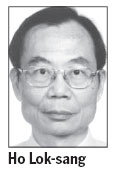HK needs to establish a workable pension scheme
Updated: 2012-12-11 05:44
By Ho Lok Sang(HK Edition)
|
|||||||||
The Hon. Tommy Cheung Yu-yan, chairman of the Finance Committee of the Legislative Council, succeeded in pushing through the enhanced Old Age Allowance of HK$2,200 for needy seniors, without legislators being fully aware of what was happening. The end of the wrangle over funding the program brought relief to the SAR government and those elderly who have been waiting for the extra dollars since the plan was announced earlier this year.
The continued filibuster by some legislators, particularly "Long Hair" Leung Kwok-hung, held up the plan for well over a month. The opposition arose from the government's insistence the applicants for the allowance must file a declaration of assets, to ensure their assets and income don't exceed the government established ceiling. The SAR government, on the other hand, has maintained that the tabled plan was the best the government can do, and would not give in.
Much of public opinion supports the government's position. Many are concerned that lifting the asset limits would lead to a burden on the government and taxpayers that would be too much to bear, and eventually undermine the government's capacity to serve needy people. However, legislator Fernando Cheung argued that an enhanced old age allowance without any asset limits would serve a transitional purpose, and put pressure on the government to introduce a universal public pension plan. From what I gather, there is consensus that the current Mandatory Provident Fund (MPF) is grossly inadequate, and that seriously tackling the problem of population aging soon will be wise.

I have in this column (Aug 16 2011) as well as on other occasions and platforms, proposed a community-wide cohort-based pension plan that will prove sustainable and affordable. I have not seen any serious or valid criticism of my plan, which is truly fully funded, and which takes care of the longevity risk as well as the risk of uncertain investment returns. This may sound too good to be true, but it is true. The one concern that some have expressed is that during the transitional period, already more or less aged cohorts will not have saved enough to look after their retirement needs. But I will deal with that one, too.
Let me just stipulate the several key features of the proposed cohort-based pension plan:
First, members born in the same year will contribute equal amounts during their working years into a common pool specific to each cohort. From that pool, members will draw their stipends as long as they survive. Given the intended stipend, the contributions will be large enough to cover the pay-outs. So this is a fully-funded plan.
Second, those who stay at home to take care of children will have their contributions paid by their working spouses.
Third, the government will subsidize the contributions of those who pass a means test. Since the contributions are made ahead of time, the government subsidy will not affect the fully-funded nature of the pension plan.
Fourth, the government will guarantee that investments will net a minimum real rate of return at 2 percent. The government will contribute to make up for any shortfall that may appear in each year, but will tax 50 percent of all returns in excess of 2 percent. This arrangement ensures that each cohort will make at least 2 percent real rate of return even in "lean years", though it will also reduce the gains during the good years.
During the transitional period, the government will set up a standard annuity plan for people to buy. Older people can use the funds in their MPF accounts and other funds at their disposal to buy the standard annuity plan, which will offer a stipend enough to meet basic living requirements. The government will subsidize the purchase through a means test. What distinguishes this plan from the Old Age Allowance is that instead of requiring the elderly to pass a means test in order to receive the stipend, I am proposing that the government subsidize the purchase of an annuity plan when an elderly person does not have sufficient means to buy such a plan.
Under the government's proposal, an elderly person with assets (not counting the value of the owner-occupied flat) worth more than HK$186,000 will not qualify for the stipend. Under my proposal, the elderly person with say HK$200,000 will receive a smaller subsidy than the elderly person with HK$180,000 when they buy the standard annuity. This is fair because someone who owns HK$200,000 is somewhat better off than someone who owns HK$180,000. But denying the elderly with HK$200,000 any benefit at he all, does not seem right.
There are good reasons why the government should be worried about pay-as-you-go schemes, because it is impossible to determine whether such schemes are fiscally sustainable. There is just too much uncertainty about medical breakthroughs and fertility rates. But my cohort-based pre-paid plan is truly free of those worries.
The author is the director of Centre for Public Policy Studies, Lingnan University.
(HK Edition 12/11/2012 page3)